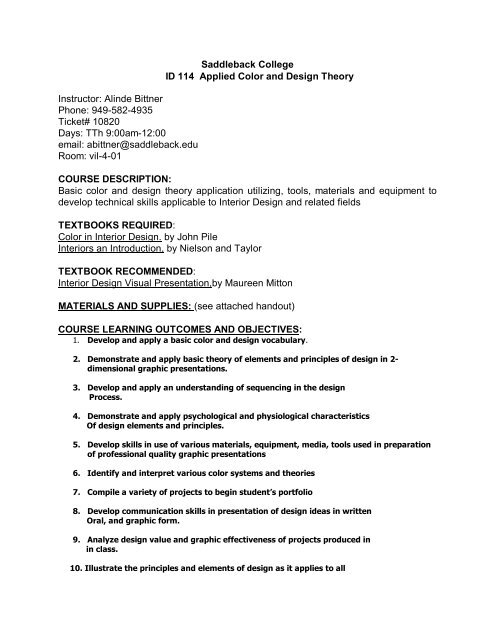Saddleback College ID 114 Applied Color and Design Theory ...
Saddleback College ID 114 Applied Color and Design Theory ...
Saddleback College ID 114 Applied Color and Design Theory ...
Create successful ePaper yourself
Turn your PDF publications into a flip-book with our unique Google optimized e-Paper software.
Instructor: Alinde Bittner<br />
Phone: 9495824935<br />
Ticket# 10820<br />
Days: TTh 9:00am12:00<br />
email: abittner@saddleback.edu<br />
Room: vil401<br />
<strong>Saddleback</strong> <strong>College</strong><br />
<strong>ID</strong> <strong>114</strong> <strong>Applied</strong> <strong>Color</strong> <strong>and</strong> <strong>Design</strong> <strong>Theory</strong><br />
COURSE DESCRIPTION:<br />
Basic color <strong>and</strong> design theory application utilizing, tools, materials <strong>and</strong> equipment to<br />
develop technical skills applicable to Interior <strong>Design</strong> <strong>and</strong> related fields<br />
TEXTBOOKS REQUIRED:<br />
<strong>Color</strong> in Interior <strong>Design</strong>. by John Pile<br />
Interiors an Introduction, by Nielson <strong>and</strong> Taylor<br />
TEXTBOOK RECOMMENDED:<br />
Interior <strong>Design</strong> Visual Presentation,by Maureen Mitton<br />
MATERIALS AND SUPPLIES: (see attached h<strong>and</strong>out)<br />
COURSE LEARNING OUTCOMES AND OBJECTIVES:<br />
1. Develop <strong>and</strong> apply a basic color <strong>and</strong> design vocabulary.<br />
2. Demonstrate <strong>and</strong> apply basic theory of elements <strong>and</strong> principles of design in 2<br />
dimensional graphic presentations.<br />
3. Develop <strong>and</strong> apply an underst<strong>and</strong>ing of sequencing in the design<br />
Process.<br />
4. Demonstrate <strong>and</strong> apply psychological <strong>and</strong> physiological characteristics<br />
Of design elements <strong>and</strong> principles.<br />
5. Develop skills in use of various materials, equipment, media, tools used in preparation<br />
of professional quality graphic presentations<br />
6. Identify <strong>and</strong> interpret various color systems <strong>and</strong> theories<br />
7. Compile a variety of projects to begin student’s portfolio<br />
8. Develop communication skills in presentation of design ideas in written<br />
Oral, <strong>and</strong> graphic form.<br />
9. Analyze design value <strong>and</strong> graphic effectiveness of projects produced in<br />
in class.<br />
10. Illustrate the principles <strong>and</strong> elements of design as it applies to all
aspects of design<br />
COURSE OUTLINE:<br />
Date Topic Assignment<br />
_______________________________________________________________<br />
Jan.9/11<br />
Jan.16/18<br />
Jan.23/25<br />
Introduction <strong>and</strong> Course Orientation<br />
The <strong>Design</strong> Process<br />
Mini Assign: Line Study<br />
<strong>Design</strong> Elements: Space,Line Shape <strong>and</strong> Form<br />
Mini Assign: Line Study<br />
<strong>Design</strong> Elements: Texture,Pattern <strong>and</strong> Light<br />
<strong>Design</strong> Principles: Unity & Variety, Balance, Rhythm<br />
Mini Assign: Geometric Shapes<br />
I.I. Chap.1<br />
I.I Chap.3<br />
I.I.Chap.3<br />
Jan.30/Feb.1 <strong>Design</strong> Principles: Scale, Size <strong>and</strong> Proportion I.I Chap.7<br />
Mini Assign: NOTAN<br />
Feb.6/9<br />
<strong>Design</strong> Elements <strong>and</strong> Principles: Physiological Aspects <strong>and</strong><br />
psychlogical Factors<br />
Mini Assign: NOTON<br />
Feb.13/15 <strong>Color</strong>: Introduction <strong>Color</strong> Chaps.13<br />
<strong>Color</strong> Wheel <strong>Color</strong> Chap. 5<br />
Mini Assign: COLOR WHEEL<br />
QUIZ: ELEMENTS AND PRINCIPLES<br />
Feb.20/22 <strong>Color</strong> Attributes: <strong>Color</strong> Chap. 5<br />
Hue, Value, <strong>and</strong> Chroma<br />
Lab: Exercises/Hue <strong>and</strong> Tints<br />
Feb.27<br />
Mar.1<br />
<strong>Color</strong> Attributes: continued<br />
Lab: <strong>Color</strong> Exercises: Tones <strong>and</strong> Shades<br />
Mar.6/8 <strong>Color</strong> Systems: <strong>Color</strong> Chap.4<br />
Lab: <strong>Color</strong> Neutralization<br />
Mar. 1216<br />
SPRING BREAK
Mar.20/22 <strong>Color</strong> Psychology Chap. 11<br />
Lab: <strong>Color</strong> of Natural Materials<br />
Lab: Introduction to Marker <strong>and</strong> Pencil Rendering<br />
Application <strong>and</strong> Effects<br />
Mar.27/29 <strong>Color</strong> Schemes <strong>Color</strong> Chap.7<br />
QUIZ COLOR<br />
Apr.3/5 <strong>Color</strong> Schemes in Practice <strong>Color</strong> Chap.8 & 10<br />
Analysis of <strong>Color</strong> Schemes<br />
Apr.10/12<br />
<strong>Color</strong> Harmonies<br />
Lab: Creating <strong>Color</strong> Harmonies<br />
Apr.17/19 Compositional Effects <strong>and</strong> <strong>Color</strong> Interactions <strong>Color</strong> Chaps3/4<br />
Apr.24/26<br />
<strong>Color</strong> In Residential <strong>and</strong> Nonresidential Interiors<br />
<strong>Color</strong> Reference Journal Due!!!!<br />
<strong>Color</strong> Chap.12<br />
May 1/3 Work with <strong>Color</strong> <strong>Color</strong> Chap.14<br />
<strong>Color</strong> Trends <strong>and</strong> <strong>Color</strong> Forecasting<br />
Lab: Final Project<br />
May 8<br />
May 15<br />
Review for Final<br />
Presentation of Final Projects<br />
FINAL EXAM<br />
10:1512:00
METHODS OF EVALUATION:<br />
GRADING POLICY: Final grades will be determined by cumulative points.<br />
A 90100%<br />
B 8980%<br />
C 7970%<br />
D 6960%<br />
F Below 60%<br />
ASSIGNMENTS:<br />
<strong>Color</strong> Reference Journal 250<br />
FOUR 2 Dimensional <strong>Design</strong><br />
MiniAssignments: 50pts.ea 200<br />
Quiz (2) 100<br />
Periodical Summary/Report 50<br />
Class Compositional Exercises 100<br />
Attendance/Participation 50<br />
Final Project 150<br />
Final Exam 100<br />
________<br />
1000 points total<br />
CLASS AND PROJECT POLICIES:<br />
Attendance: A part of your grade is based on attendance, college policy states that any student may be<br />
dropped from class if absent more than six hours without advance notice from the instructor. Please keep<br />
me advised if you must be absent for more than two consecutive class meetings.<br />
This is a Studio class in which your attendance <strong>and</strong> participation<br />
is expected! Plan to arrive ON TIME <strong>and</strong> stay through the duration of class.<br />
DROPPING THE CLASS:<br />
If you must drop it is your responsibility!!!!<br />
No penalty drop date Feb.14<br />
Last day to apply for CR/NCR Feb.13<br />
Last day to drop with "W" is Apr.4<br />
PROJECTS:<br />
All course work is to be done in a neat <strong>and</strong> professional<br />
manner. Written work should be typed <strong>and</strong> presented in a folder or<br />
manila envelope.<br />
Late projects are subject to a loss of total points. No project accepted more than two weeks late. Late<br />
projects must be turned in by Final exam.<br />
All projects will receive a departmental stamp to indicate they have been graded.<br />
There will be inclass assignments. Makeups will not be possible.<br />
EXAMS:<br />
Must be made up by the following class meeting. You must make arrangements with me to makeup the<br />
quizoutside of normal class hours. Sorry NoMakeups for final exam.
ACADEMIC INTEGRITY:<br />
Under no circumstances are you to turnin work that is not entirely<br />
<strong>and</strong> originally created by you! Cheating of any type is grounds for immediate dismissal!

















